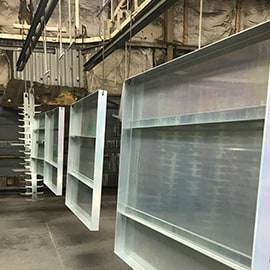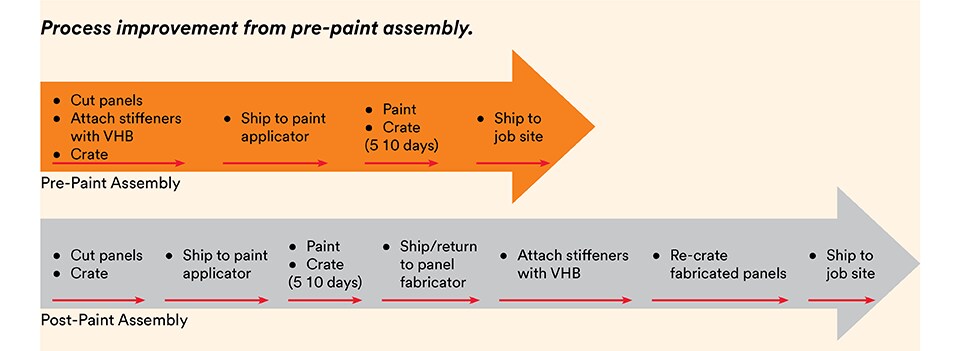-
The art of tape technology... bringing architectural facades to life.
December 01, 2020The art of tape technology... bringing architectural facades to life.
-
With the rapid increase of advanced lightweight materials, designers and architects have access to a wide array of architectural cladding and profiles that allow them to design without boundaries. Today’s modern construction and engineering design practices offer functional and versatile exterior finishing systems to meet aesthetic and functional needs that stand the test of time. They not only offer contemporary and attractive facade solutions, but serve to provide quicker build times, and environmental efficiency due to their thermal performance which reduces energy consumption for the life of the building.
-
Architectural facade panels.
Lightweight architectural facade panels wrap the external walls of a building, covering the substructure to finish and enhance their overall appearance, improve efficiency and act as a barrier against the elements. Widely used, the system provides a high strength cost-effective solution that offers flexibility and extensive design potential, from shape through to colour, for an appealing and protected structure that requires minimal maintenance on both new constructions and in facade remediation. Their ability to be installed onto a variety of substrates makes them an adaptable and versatile solution on many projects.
The facade is an essential element of any building, even though there is a wide selection of architectural cladding and panel products available on the market, in many cases, the cladding panel system is to be comprised of non-combustible materials. The current trend for both remediation and replacement of combustible aluminium composite panels (APC) and new construction, is for the installation of solid aluminium panels. Whilst these panels are affixed to the structure and are non-load bearing, they do need to stand up to the environmental stresses applied to them in service. Depending on the size, thickness and wind-load applied to the panels, additional stiffening may be required through attachment of metal profiles to the rear of the panel - either floating or attached back to a perimeter frame.
-
Stiffener to panel assembly
What are stiffener to panel assemblies?
Stiffener to panel assemblies refers to the process of applying reinforcing bars, known as stiffeners, to the back of architectural facade panels to provide extra support and rigidity. They allow the panels to lay straight, withstand wind and severe weather conditions and prevents them from losing their structural integrity over time.
Bonding stiffeners to panel assemblies require an attachment solution that is fit for purpose. This application requires a flexible attachment system that allows for thermal expansion and contraction of the panel, versus stiffener. It also minimises the potential of oil canning, the visible waviness in the flat areas of facade panels that may occur with rigid stiffener attachment methods.
Stiffener bonding methods.
Stiffeners are bonded to facade panels via several methods; welds, mechanical fasteners, liquid adhesives and even tapes. Traditional mechanical fixings, however, means that rivets or screws are visible on the panels surface and can present difficulties in the assembly process due to deformation or tearing, thereby reducing the reliability and longevity of assembled parts. Welding can damage metal surfaces by causing heat distortion, burn-through, or visible scarring, especially with lighter weight substrates that often requires additional work to return the components to a condition suitable for finishing and painting. Liquid adhesive sealants tend to shrink after curing, this shrinkage can result in isolated panel stress that may be visible on the exterior face of the architectural panel. These methods are more likely to damage the integrity and aesthetic appearance of the panel.
High strength acrylic foam tapes provide an alternative to traditional fixing methods. They can replace liquid adhesives, sealants, welds and mechanical fasteners for a clean invisible means of attachment. Imparting a smooth, clean appearance, one that enhances the beauty of the overall facade by eliminating unsightly mechanical fasteners. High strength acrylic foam tapes are a proven alternative to screws, rivets, welds and other mechanical fasteners that solves the problems presented by traditional joining methods. They offer instant strength, a high ultimate bond and stress distribution that allows relative movement of parts for thermal expansion and contraction. They have the added advantage of speeding up the assembly process and reducing labour costs.
-
3M VHB Tapes are easy to apply to simplify the bonding/attachment process.
3M™ VHB™ architectural panel tapes.
3M invented VHB Tapes in 1980, which were the first of their kind. In the forty years since they have been providing proven bonding solutions that outperform mechanical fasteners in a variety of applications. 3M™ VHB™ Tapes are high-performance double-sided pressure sensitive acrylic foam tapes used in the fabrication of architectural panel systems for quick, permanent assembly of stiffeners to facade panels, including aluminium composite material (ACM) panels and plate metal panels (aluminium and stainless steel).
3M™ VHB™ Tapes provide a fast and easy-to-use permanent bonding method for an ideal combination of high strength, long-term durability, performance and application. These invisible and durable attachment systems are quick, easy to process and provide an instant bond for immediate handling during the fabrication process. Their vibration absorption properties combined with the unique capacity to bond two different substrates together are all packaged in one solution to provide design flexibility and create visibly stunning facades. 3M ™ VHB ™ Tapes for architectural panel applications expand architectural design options and increase production efficiency through:
- • Simplified process - Easy to apply bonding solution
- • Increased productivity - Immediate handling strength, reduces assembly and delivery time
- • Improved appearance - Eliminates drilling, grinding, refinishing, screwing, welding and associated re-work
- • Less waste - Typically, less than 2% waste factor
-
 3M VHB Tape GPH 160 allows stiffeners to be bonded prior to a paint bake cycle.
3M VHB Tape GPH 160 allows stiffeners to be bonded prior to a paint bake cycle.3M™ VHB™ Tape GPH-160GF.
3M™ VHB™ Tape GPH-160GF is a new innovation for architectural panel applications that solves the challenges of panel assembly before a paint-bake cycle. This 1.6 mm thick grey double-sided acrylic foam tape with superior high-temperature performance (up to 230 ° C for short periods), is suitable for use on pre-finished panels or for assembly prior to liquid paint or powder coat processes involving a paint bake cycle, making it the ideal solution for stiffeners applied to architectural metal panels. It allows increased manufacturing efficiency through reduced touch points and streamlined processes. As illustrated in the diagram below, the elimination of unnecessary handling and transportation frees-up time to take on additional projects, and most importantly, allows panels to be delivered to the job site quicker.


-
Ask a 3M™ VHB™ Tapes Expert.
3M™ VHB™ Tapes help you design beyond the limits of mechanical fasteners, to build better products, improve productivity and enhance performance. Contact a 3M Industrial Adhesive & Tape Specialist who can:
- • Assist with finite element analysis to optimise the amount of VHB tape for a range of designs and wind loads
- • Provide an extensive range of architectural panel and combustibility test data
- • Supply testing and project-specific application procedures
Experience the strength and reliability of 3M™ VHB™ Tapes for architectural panel applications. Contact a 3M Expert today to help you find the correct VHB™ Tapes for your project, product design or production process.
Designers / installers are to seek independent advice to determine the suitability and use of VHB tapes and compliance with the National Construction Code for a particular project.
-


